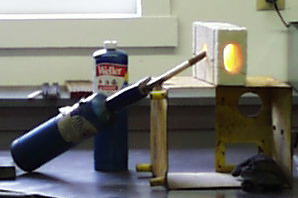|
|
| |
| |
|
|
|
|
|
|
|
|
| |
| |
| |
| |
| |
| |
| |
| |
| |
| |
|




| |
| |
|
Tell them you found it on anvilfire.com!
|
Blacksmithing and metalworking questions answered.
|
Blacksmithing and Metalworking Tools Historical Preservation.
|
|
|

Micro Forge
Daniel Boone's forge may not be the world's smallest forge but it certainly is simple!
Dan had this forge setup in his shop for the January 1999 Mid-Atlantic Smiths meeting at his shop in Virginia.
The "forge" is a light weight insulating brick that has been hollowed out and a hole for the torch cut in one side.
The insulating brick is very friable and easy to cut. You can carve is with a spoon or a hand held wood drilling bit.
I think Dan said he used a spoon.
The hollow passes entirely through the brick.
I would make a small hole in the back rather than a full sized opening.
The brick is fairly fragile and in this case has two binder straps wrapped around it to keep it from falling apart.
This is similar to the "bean can" forge that used to be on the Donnie Fullwood web site. - January 27, 1999 Jock Dempsey
|
 Doug's Forge is a derivation of the classic "bean can" forge.
Sadly the original drawings and article that were posted on the web are now gone and I have not been able to find a copy to post here.
This however, is a photo of first class mini-forge built by Doug Merkel and the photo should be all you need to build one.
Doug was using it to demonstrate nail headers he was selling at SOFA/QuadState September 2003.
Doug's Forge is a derivation of the classic "bean can" forge.
Sadly the original drawings and article that were posted on the web are now gone and I have not been able to find a copy to post here.
This however, is a photo of first class mini-forge built by Doug Merkel and the photo should be all you need to build one.
Doug was using it to demonstrate nail headers he was selling at SOFA/QuadState September 2003.
The first thing you will notice is the quality of the construction of this little forge.
No shortcuts were taken.
The forge shell is a new (or clean) piece of thin wall tubing and everything is well constructed.
An important feature is the long legs so that the torch can operate properly.
Propane torches do not operate properly if tilted to where the liquid fuel gets in the valve.
The burner also wants to point almost parallel to the inside surface of the forge so that the flame swirls around the surface.
It should be from 1/2 to 2/3 of the way toward the back of the forge.
This little forge is lined with Kaowool and coated with a product like ITC-100.
The burner just barely engages the side of the shell.
Otherwise it will overheat and possibly melt.
For safety the bottle is clamped to one of the forge legs.
The legs form a "T" shape and use the minimum material to make a stable base.
Added features that are VERY handy is the forge hearth and the adjustable built in stock rack.
The piece resting on the forge
made of a piece of angle iron is a stock prop with various heights to get the work piece in the hot spot.
The finishing touch was that this forge was neatly painted with high temperature barbecue black paint.
In operation this forge would heat a piece of 1/4" (6mm) round bar to forging heat in just a minute or two from lighting the forge.
Faster if the forge was pre-heated.
However, this is about the limit of the work that can be done with one of these.
5/16" (8mm) steel would probably work but 3/8" (10mm) would be very slow to heat and only a short portion would heat.
Note that this forge has no door and it is closed at the back.
The hearth blocks off a bit of the bottom and the stock rest some more.
For efficiency the opening can be narrowed with some loose refractory blocks (1/2 thick brick, pieces of kiln shelf or Kaowool sized with ITC-100).
Forge doors must be covered with refractory just like the rest of the shell.
- August 8, 2004 Jock Dempsey
MATERIALS: We sell Kaowool OR Maxwool
and ITC-100HT in our on-line store.
The minimum quantities of these products will make three or four of these forges and cost less than $100 plus shipping and handling.
(Previous cost was set at about $50 for four but the price of ITC-100 in pints more than doubled when the company was sold.
Even at the new prices the difference in using ITC-100 is significant enough in a small forge that it is highly recommended.
Insulating bricks are NOT firebricks.
They are a very light weight soft refractory that looks like styrofoam (and about the same weight).
They are not inexpensive and are only available from commercial refractory suppliers like foundry suppliers and some ceramics houses.
NOTE: We found and have reproduced the text of the original
bean can forge called the Bean-O-Matic by Ed Halligan.
It originally ran in the Ocmulgee Blacksmith Guild newsletter and was posted on the Donnie Fullwood site which no longer exists.
The original drawing was not with the archived version.
|

Copyright © 1999, 2004 by Jock Dempsey, DEMPSEY'S FORGE
|
|
|


Micro Forge
Daniel Boone's forge may not be the world's smallest forge but it certainly is simple! Dan had this forge setup in his shop for the January 1999 Mid-Atlantic Smiths meeting at his shop in Virginia.The "forge" is a light weight insulating brick that has been hollowed out and a hole for the torch cut in one side. The insulating brick is very friable and easy to cut. You can carve is with a spoon or a hand held wood drilling bit. I think Dan said he used a spoon. The hollow passes entirely through the brick. I would make a small hole in the back rather than a full sized opening. The brick is fairly fragile and in this case has two binder straps wrapped around it to keep it from falling apart. This is similar to the "bean can" forge that used to be on the Donnie Fullwood web site. - January 27, 1999 Jock Dempsey
The first thing you will notice is the quality of the construction of this little forge. No shortcuts were taken. The forge shell is a new (or clean) piece of thin wall tubing and everything is well constructed. An important feature is the long legs so that the torch can operate properly. Propane torches do not operate properly if tilted to where the liquid fuel gets in the valve. The burner also wants to point almost parallel to the inside surface of the forge so that the flame swirls around the surface. It should be from 1/2 to 2/3 of the way toward the back of the forge.
This little forge is lined with Kaowool and coated with a product like ITC-100. The burner just barely engages the side of the shell. Otherwise it will overheat and possibly melt. For safety the bottle is clamped to one of the forge legs. The legs form a "T" shape and use the minimum material to make a stable base.
Added features that are VERY handy is the forge hearth and the adjustable built in stock rack. The piece resting on the forge made of a piece of angle iron is a stock prop with various heights to get the work piece in the hot spot.
The finishing touch was that this forge was neatly painted with high temperature barbecue black paint.
In operation this forge would heat a piece of 1/4" (6mm) round bar to forging heat in just a minute or two from lighting the forge. Faster if the forge was pre-heated. However, this is about the limit of the work that can be done with one of these. 5/16" (8mm) steel would probably work but 3/8" (10mm) would be very slow to heat and only a short portion would heat.
Note that this forge has no door and it is closed at the back. The hearth blocks off a bit of the bottom and the stock rest some more. For efficiency the opening can be narrowed with some loose refractory blocks (1/2 thick brick, pieces of kiln shelf or Kaowool sized with ITC-100). Forge doors must be covered with refractory just like the rest of the shell. - August 8, 2004 Jock Dempsey
MATERIALS: We sell Kaowool OR Maxwool and ITC-100HT in our on-line store. The minimum quantities of these products will make three or four of these forges and cost less than $100 plus shipping and handling. (Previous cost was set at about $50 for four but the price of ITC-100 in pints more than doubled when the company was sold. Even at the new prices the difference in using ITC-100 is significant enough in a small forge that it is highly recommended.
Insulating bricks are NOT firebricks. They are a very light weight soft refractory that looks like styrofoam (and about the same weight). They are not inexpensive and are only available from commercial refractory suppliers like foundry suppliers and some ceramics houses.
NOTE: We found and have reproduced the text of the original bean can forge called the Bean-O-Matic by Ed Halligan. It originally ran in the Ocmulgee Blacksmith Guild newsletter and was posted on the Donnie Fullwood site which no longer exists. The original drawing was not with the archived version.
Copyright © 1999, 2004 by Jock Dempsey, DEMPSEY'S FORGE